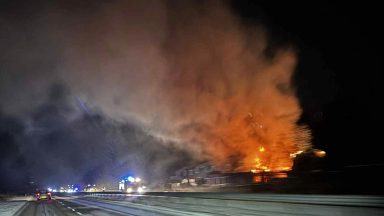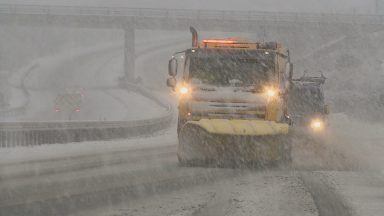Storm Agnes is set to hit Scotland on Wednesday, with serious wet and blustery weather affecting most of the country.
The first storm of the season is expected to bring winds of up to 80mph and approximately 60mm of rainfall with a Met Office yellow weather warning in place.
The blustery conditions will begin on Wednesday morning and are set to last until Thursday night.
Weather maps show the storm reaching Glasgow around 1pm before spreading across most of the country by 4pm.
A “danger to life” wind warning is in place from 12pm on Wednesday and is set to last until Thursday at 7am.
Southwest Scotland could see the highest impacts of wind along with north west Wales, Cumbria and Lancashire and Northern Ireland.
The second warning for rain lasts from Wednesday at 3pm until midnight on Thursday.
Met Office chief meteorologist Matthew Lehnert said: “Storm Agnes will approach southwest Ireland early on Wednesday and track northeast across Northern Ireland and Scotland before clearing on Thursday morning. Gusts of 45-55 mph are expected widely inland and 50-60 mph over hills and around coasts.
“The strongest winds are expected to affect Northern Ireland, south west Scotland, west and north west Wales, Cumbria and Lancashire where some places inland may see gusts of 60mph and 65-75mph over hills and around coasts. These are most likely during the second half of Wednesday afternoon and through the evening.”
Warnings have been issued to those planning to travel in the height of the storm to ensure they plan ahead and take extra care.
Steve Basterfield, national network manager at National Highways, said: “With the stormy weather being forecast, it is important to plan ahead for your journey, and if weather conditions become challenging, adjust your driving behaviour and take extra care.
“We have a section of our website dedicated to travelling amid storms, high winds and gales, and considerations for different types of vehicle, as part of our guide to travelling in severe weather. It’s also a good idea for people to check their vehicles, such as tyres, coolant and oil levels, before heading out to reduce the risk of breakdowns.”
On Tuesday, STV meteorologist Sean Batty said: “With trees still pretty much in full leaf this increases the risk of branches coming down in winds this strong, which if they fall onto railway tracks or roads could lead to delays.”
He added: “The weather should settle a little later in the week, but beyond that is a lot more uncertain with some computer models continuing with the windy and occasionally stormy theme while others indicate a more settled period.
“While we have this divergence longer term forecasting is tricky, but for now it’s unsettled and wet, but it should at least be a fairly mild week ahead.”
Warnings have been issued from RNLI who have said the storm poses a safety risk to those visiting the coast and the lifesaving charity is urging the public to exercise extreme caution, particularly along exposed cliffs, seafronts and piers.
RNLI Water Safety Partner, Sam Hughes, said: “The forecasted strong winds along with heavy rain are likely to cause dangerous conditions for those visiting the coast around the UK and Ireland.
“The RNLI advises staying a safe distance away from the water and cliff edges as the conditions could knock you off your feet or wash you into the sea. It is not worth risking your life.
“If you see someone else in danger in the water, call 999 or 112 and ask for the Coastguard. If you have something that floats that they can hold on to, throw it to them. Don’t go in the water yourself – you may end up in difficulty too.”
Network Rail have also announced they are making preparations for the storm.
In a statement the rail operator said: “Storm Agnes is the first named storm of the autumn and winter season, and she’s due to arrive in Scotland on Wednesday afternoon. Widespread heavy rain and strong winds have the potential to cause disruption.
“We’ve just caught up with colleagues across the railway to discuss our preparations. Weather specialists based in the Scotland’s Railway control room are assessing where we may need to slow trains down for safety reasons. We’ll confirm this info as soon as we can.
“Teams are checking pumps in areas at risk of flooding, and we’ll monitor high tide at Saltcoats and Craigendoran, where waves can crash over the sea walls onto the railway. Chainsaw teams are also ready to respond if we see any trees coming down due to the strong winds.
“If you’re due to travel on Scotland’s Railway over the next few days, check http://nationalrail.co.uk or with your train operator before you leave the house.”
Follow STV News on WhatsApp
Scan the QR code on your mobile device for all the latest news from around the country





























